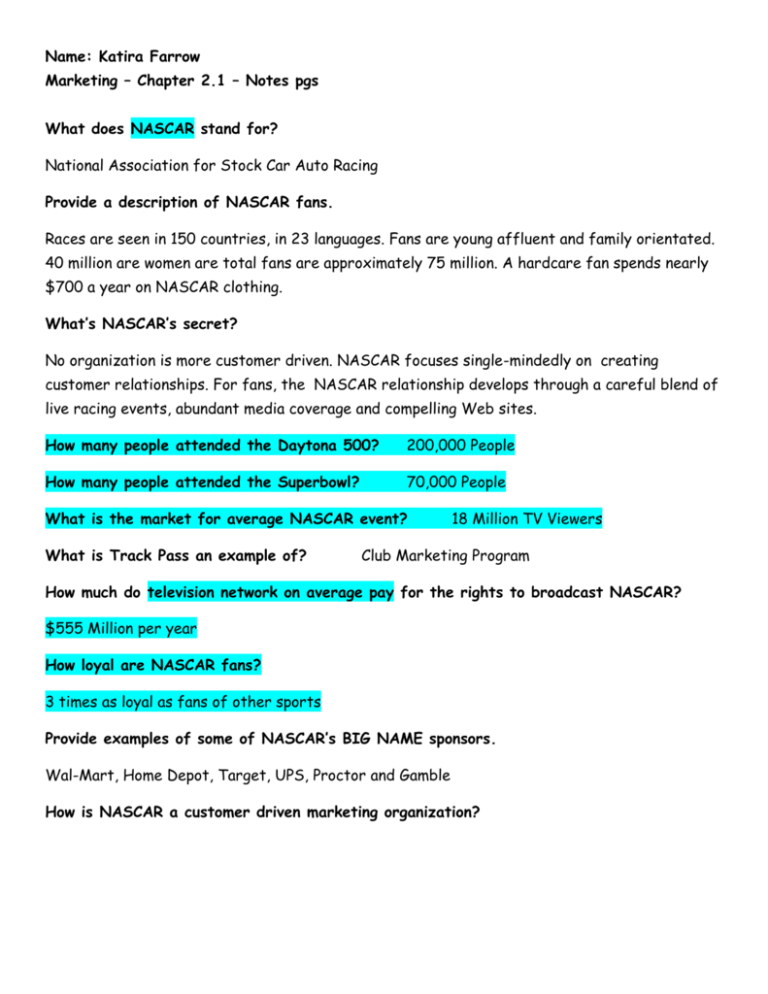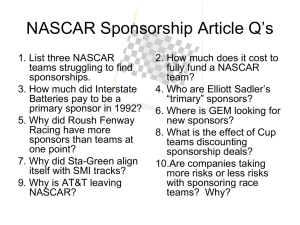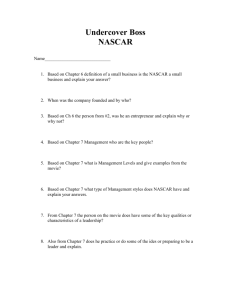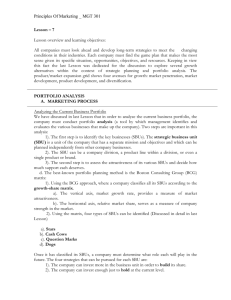Chapter 2 Notes
advertisement

Name: Katira Farrow Marketing – Chapter 2.1 – Notes pgs What does NASCAR stand for? National Association for Stock Car Auto Racing Provide a description of NASCAR fans. Races are seen in 150 countries, in 23 languages. Fans are young affluent and family orientated. 40 million are women are total fans are approximately 75 million. A hardcare fan spends nearly $700 a year on NASCAR clothing. What’s NASCAR’s secret? No organization is more customer driven. NASCAR focuses single-mindedly on creating customer relationships. For fans, the NASCAR relationship develops through a careful blend of live racing events, abundant media coverage and compelling Web sites. How many people attended the Daytona 500? 200,000 People How many people attended the Superbowl? 70,000 People What is the market for average NASCAR event? What is Track Pass an example of? 18 Million TV Viewers Club Marketing Program How much do television network on average pay for the rights to broadcast NASCAR? $555 Million per year How loyal are NASCAR fans? 3 times as loyal as fans of other sports Provide examples of some of NASCAR’s BIG NAME sponsors. Wal-Mart, Home Depot, Target, UPS, Proctor and Gamble How is NASCAR a customer driven marketing organization? Company Wide Strategic Planning: Defining Marketing’s Role Strategic Planning – The process of developing and maintaining a strategic fit between the organization’s goals and capabilities and its changing marketing opportunities. How is strategic planning different from a company’s one, two or 5 year plan? Strategic planning involves adapting the firm to take advantage of opportunities in its constantly changing environment. What is a company’s Portfolio of Business? The different products and services the company chooses to sell and support Marketing planning occurs at the business-unit, product, and market levels. It supports company strategic planning with more detailed plans for specific marketing opportunities. What questions do mission statements answer? What is our business? Who is the customer? What do consumers value? What should our business be? Mission Statement – A statement of the organization’s purpose-what it wants to accomplish in the larger environment. What is meant, when a mission statement is market orientated? It defines the business in terms of satisfying basic customer needs. Marketing objectives should be designed to support a well crafted mission statement. What are created to support the marketing objectives? Marketing strategies and programs support marketing objectives. Guided by the company’s mission statement and objectives, management now must plan its business portfolio-the collection of businesses and products that make up the company. The best business portfolio is the one that best fits the company’s strengths and weaknesses to opportunities in the environment. Business portfolio planning involves two steps. First, the company must analyze its current business portfolio and decide which businesses should receive more, less or no investment. Second, it must shape the future portfolio by developing strategies for growth and downsizing. Portfolio Analysis- The process by which management evaluates the products and businesses making up the company. What is the first step to portfolio analysis? Identify the key businesses making up the company into SBUs. What is a strategic business unit? A unit of the company that has a separate mission and objectives and that can be planned independently from other company businesses. An SBU can be a company division, a product line within a division, or sometimes a single product or brand What is the second stop to portfolio analysis? Calls for management to assess the attractiveness of its various SBUs and decide how much support each deserves. What is the purpose of strategic planning? To find ways in which the company can best use its strengths to take advantage of attractive opportunities in the environment. What are the two methods used to evaluate SBUs? 1. The attractiveness of the SBU’s market or industry 2. Strength of the SBUs position in that market or industry The Boston Consulting Group Approach created the best known portfolio planning matrix, called the Growth Share Matrix. Growth-share Matrix- A portfolio-planning method that evaluates a company’s strategic business units in terms of their market growth rate and relative market share. SBU’s are classified as stars, cash cows, question marks or dogs. Label and Complete the Growth-share Matrix below: Stars Cash cows Question marks Dogs Stars: are high-growth, high share businesses or products. They often need heavy investment to finance their rapid growth. Eventually their growth will slow down and they will turn into cash cows. Cash Cows: are low-growth, high share businesses or products. These established and successful SBUs need less investment to hold their market share. Thus, they produce a lot of cash that the company uses to pay its bills and to support other SBUs that need investment. Question Marks: are low-share business units in high-growth markets. They require a lot of cash to hold their share, let alone increase it. Management must think hard about which question marks it should try to build into stars and which should be phased out. Dogs: are low-growth, low-share businesses and products. They may generate enough cash to maintain themselves but do not promise to be large sources of cash. After classifying the different SBUs the company must determine what role each will play in the future. One of four, strategies can be pursued for each SBU. 1. Build Its Share- invest more in the business 2. Invest just enough to hold the SBU’s share at the current level 3. Harvest the SBU, milking its short-term cash flow regardless of the long-term effect. 4. Divest the SBU by selling it or phasing it out and using the resources elsewhere. What are the problems with the Growth-share Matrix? 1. They can be difficult, time consuming and costly to implement. 2. Management may find it difficult to define SUBs and measure market share and growth. 3. In addition, these approaches focus on classifying current businesses but provide little advice for future planning.




